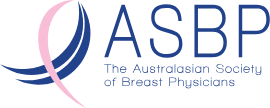About the Australasian Society of Breast Physicians (ASBP)
The Australasian Society of Breast Physicians (ASBP) is a not-for-profit professional society for doctors who have a specific interest in Breast Medicine.
Breast Medicine is a patient-centred, community-based practice at the intersection of clinical assessment, radiological investigation and medical management of breast disease.
The ASBP provides a training program, representation and networking opportunities for doctors practicing breast medicine in Australia and New Zealand, many of whom are also General Practitioners.
The evolution of breast physicians
For over 40 years breast physicians have formed an integral part of multidisciplinary management teams in breast-diagnostic and breast-screening units in Australia. They provide a holistic approach to the investigation and management of breast disease and are experts in both the clinical and imaging assessment of breast symptoms. In addition to being an integral part of the multidisciplinary team, Breast Physicians also work as independent practitioners administering their own practices.
The practice of multidisciplinary breast teams began in 1978, when a group of doctors with a particular interest in breast diagnosis, adopted a collaborative approach and established the Sydney Breast Clinic. This was followed in 1982 by the Wesley Breast Clinic in Brisbane, and in the early 1990s by various New Zealand clinics, generally following the same model.
In these multidisciplinary clinics, women and men with breast symptoms are able to have all their clinical, imaging and interventional diagnostic procedures performed in one visit, at one location – a vast improvement on the fragmented approach otherwise required. This coordinated approach improves the diagnosis and management of patients with breast cancer and benign breast conditions.

These clinics soon recognised that in addition to surgeons and radiologists there was a need for clinicians with a detailed knowledge of breast disease, diagnostic expertise, and skills in providing advice, follow-up and management. This particularly applies to those benign breast conditions where surgery is not needed, and for which medical and hormonal advice might be useful.
Doctors were mainly recruited from general practice backgrounds and received on-the-job training in breast medicine, breast imaging and diagnostic procedures. Subsequently, they became known in Australia and New Zealand as breast physicians and in the UK as breast clinicians, and the role expanded to include breast cancer risk assessment and screening, genetic assessment, counselling, triaging, planning and coordinating pre- and post-surgical management, and breast cancer survivorship.
The multidisciplinary breast team has also evolved to include breast care nurses, geneticists, breast imaging technicians, and medical and radiation oncologists, however, breast physicians, who sit at the intersection of clinical, radiological and management functions, continue to have a pivotal role, ensuring that the team operates in an interactive and collaborative manner and able to perform a wide range of functions in each of these disciplines.
Settings of Practice
Dedicated breast units (public or private):
The breast physician/clinician role encompasses examining patients, interpreting breast imaging, undertaking and interpreting sonography, performing interventional procedures including nipple punch biopsy, abscess drainage and ultrasound-guided and mammographically-guided breast biopsies and pre-operative imaging localisations. It includes management of benign conditions as well as maintaining surveillance, performing risk assessment, counselling and management of patients at increased risk of breast cancer and investigating and managing women with breast implant related issues. It includes triage and work-up of patients for surgery, but also involves recognising which patients do not need surgical intervention and managing them appropriately by non-surgical means.
BreastScreen services:
The role varies according to local requirements, but usually involves reading and reporting screening mammograms, clinical assessment and diagnostic evaluation of women with mammographic abnormalities, performing ultrasound and tomosynthesis guided breast biopsies, managing and coordinating multidisciplinary teams, liaising with GPs and breast surgeons, correlating results and meeting the quality assurance requirements of a population screening program.
Collaborative practices:
In private practice, breast physician/clinicians often see women who don’t need the services of a surgeon, but whose presentation is beyond the scope of the average GP. They may share rooms with breast surgeons and radiologists in private practices and/or public hospital outpatient settings. The scope of practice is similar to the above, but often is focussed on investigation and management of non-surgical, non-oncological breast issues.
General Practice
Many breast physician/clinicians also continue to work part-time in general practice, allowing integration of their knowledge and practical experience in Breast Medicine into their wider practice.
Supporting our Society
The ASBP welcomes your input. Whether you are a current member, thinking of becoming a member, or you are someone working in the area of breast diagnosis and treatment, we value your ideas.
Please contact any of the members of the Executive and let us know your thoughts on any issues related to Breast Physicians.
Breast Physician vs Breast Clinician
The ASBP advises that in Australia the descriptor
“Breast Physician” should be reserved for medical practitioners who have undergone the formal training and accreditation program leading to Fellowship of the ASBP, and who maintain their membership status with the ASBP. The ASBP advises members who do not currently hold a Fellowship of the ASBP to refer to themselves as a “Breast Clinician”, or as a “Breast Physician Trainee” for those who are in training.
What are the current objectives of the Society?
- Develop Breast Medicine as an area of advanced credentialled practice
- Remove existing barriers and develop a more streamlined pathway for GPs wishing to enter the practice of Breast Medicine
- Meet existing and future community needs by expanding the workforce of breast physician / clinicians.

